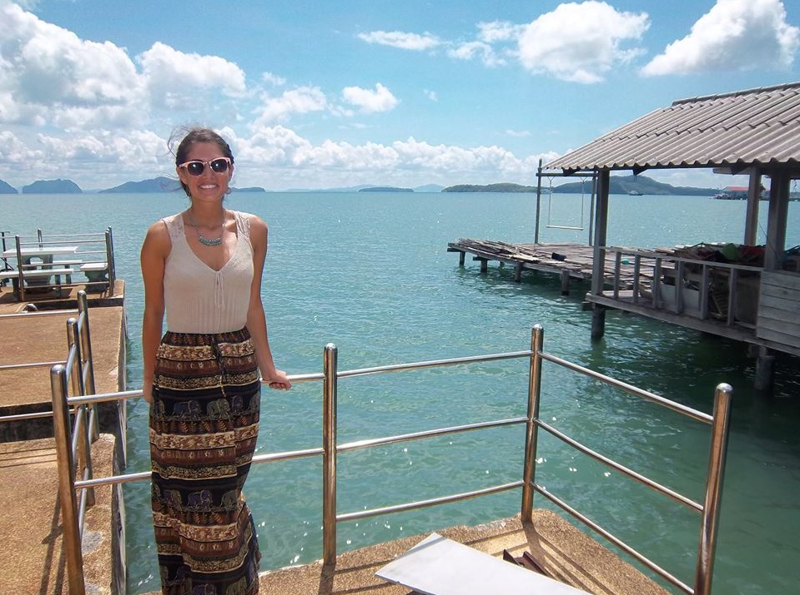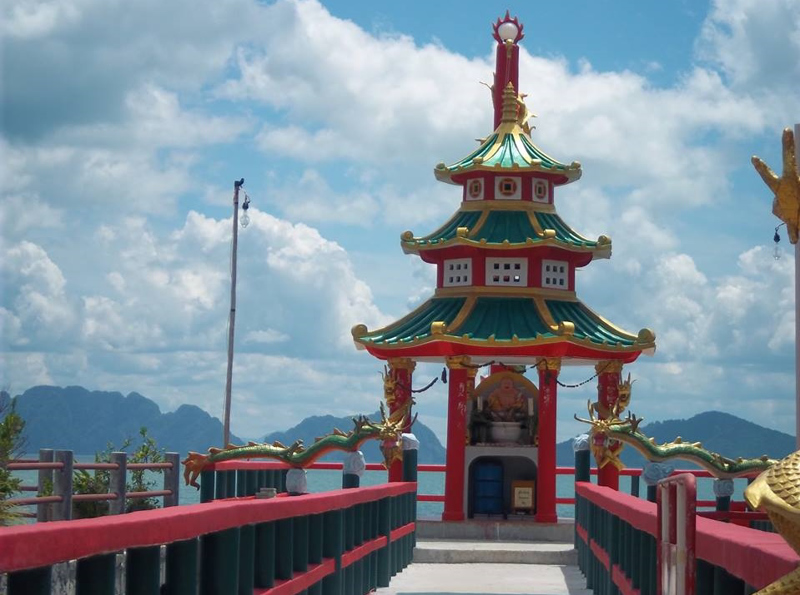Natali Euale
People develop a 'sense of place' through experience and knowledge of the history, geography and geology of an area, its flora and fauna, the stories of a place, and a growing awareness of the land (Hayden 1995). Sense of place captures authentic identity which is sensed more than measured (Hayden 1995). As Yi-Fu Tuan (1977) argues, an individual's sense of place is both a biological response of one's senses to the surrounding physical environment, and a cultural creation. After spending much time in Thailand, I began to consider the possibility that mass tourism could be impacting local communities' sense of place, their authenticity, and their place identity. Place and identity are inevitably tied together; the two concepts are co-produced as people come to identify with where they live, shape it, and are in turn shaped by their environments, creating distinctive 'environmental autobiographies', the narratives individuals hold from the memories of the places that shaped them (Hayden 1995).
Making an Unexpected Stop at the Sea Gypsy Village:
After considering the many influences on place attachment and sense of place I began to wonder, to what extent can the Sea Gypsies of Thailand (also known as the Chao Ley in Thai), who tend to live by the sea, form a relationship to the built environment that they do not know well, yet is increasingly being forced upon them? Setha Low (1992) refers to 'place attachment' as the ways in which people connect to various places, and the effects of such bonds in place-making, identity development, perception, and practice. Both concepts of place attachment and sense of place can help us understand where and why people feel at home, as well why displacement--forced or voluntary--can often be traumatic to individuals (Hayden 1995).
The Urak Lawoi are the largest of three groups of Chao Ley, which also includes the Moken and Moklen groups (Granbom 2005). Until recently, the Urak Lawoi maintained a culture, language and lifestyle that differentiated them from the rest of Thai society (Granbom 2005). However, the impacts
natali-euale
2 chapters
15 Apr 2020
Place names and Place Identity: The Sea Gypsies of Thailand
Baan Sangkha-U, Koh Lanta
People develop a 'sense of place' through experience and knowledge of the history, geography and geology of an area, its flora and fauna, the stories of a place, and a growing awareness of the land (Hayden 1995). Sense of place captures authentic identity which is sensed more than measured (Hayden 1995). As Yi-Fu Tuan (1977) argues, an individual's sense of place is both a biological response of one's senses to the surrounding physical environment, and a cultural creation. After spending much time in Thailand, I began to consider the possibility that mass tourism could be impacting local communities' sense of place, their authenticity, and their place identity. Place and identity are inevitably tied together; the two concepts are co-produced as people come to identify with where they live, shape it, and are in turn shaped by their environments, creating distinctive 'environmental autobiographies', the narratives individuals hold from the memories of the places that shaped them (Hayden 1995).
Making an Unexpected Stop at the Sea Gypsy Village:
After considering the many influences on place attachment and sense of place I began to wonder, to what extent can the Sea Gypsies of Thailand (also known as the Chao Ley in Thai), who tend to live by the sea, form a relationship to the built environment that they do not know well, yet is increasingly being forced upon them? Setha Low (1992) refers to 'place attachment' as the ways in which people connect to various places, and the effects of such bonds in place-making, identity development, perception, and practice. Both concepts of place attachment and sense of place can help us understand where and why people feel at home, as well why displacement--forced or voluntary--can often be traumatic to individuals (Hayden 1995).
The Urak Lawoi are the largest of three groups of Chao Ley, which also includes the Moken and Moklen groups (Granbom 2005). Until recently, the Urak Lawoi maintained a culture, language and lifestyle that differentiated them from the rest of Thai society (Granbom 2005). However, the impacts


of rapid tourism development are being felt by these communities through the construction of large-scale hotels and bungalow resorts, which are significantly affecting the nomadic lifestyle of the Urak Lawoi (Granbom 2005). These communities continue to be pushed farther from the shore of the Andaman Sea and into unproductive areas without access to fishing (Granbom 2005).
Lanta Old Town Near the Sea Gypsy Village of Baan Sangkha-U.
I first came upon the Urak Lawoi or Baan Sangkha-U after feeling adventurous one morning and deciding to travel to the most southern part of the island on my rented moped. I made a stop to momentarily escape from the sweltering heat and came across an interesting site. About one hundred above ground graves were lining the shore, covered by colorful umbrellas, and surrounded by what looked to be offerings of flowers, food and drinks. There was no solid covering for any of the graves, instead, the deceased were buried in the sand and their graves separated by cement blocks. I eventually found a sign in Thai that had a small translation in

English underneath it stating: This is a Sacred Burial Site of the Sea Gypsies. Being an anthropology student, I became quite intrigued by the burial practices of the 'Sea Gypsies' and was compelled to know more about this group of people. Rather than imposing on their village at the risk of appearing like another curious tourist, I decided to do some research on their culture.
Urak Lawoi Animistic Beliefs and Place Identity:
The proper name for Sea Gypsy, or sea-nomad in Thai is Chao Leh (which directly translates to people of the sea), as I previously mentioned. This specific group in Kon Lanta Lay is called the Urak Lawoi. The Urak Lawoi lifestyle is firmly connected to the sea; hook and line fishing helps sustain the Urak Lawoi communities as well as their harvesting of abundant sea life such as sea turtle, lobsters, sea cucumbers, and clams (Granbom 2005). This sea life is harvested by 'skin divers' who are capable of diving up to six meters below the ocean surface and spear fish and other sea creatures (Granbom 2005). A characteristic of this community is that they carry their homes on their boats as nomads of the sea (Granbom 2005). It is interesting to note that the people who settled on this land call themselves Urak Lawoi, meaning 'brother of the sea'. They consider themselves 'of this place' and thus named themselves for this place. This clan, like many other indigenous clans, have a name that is really a name for their places. This is how they are known to others, and to themselves. This deep attachment to the sea is seen in their animistic beliefs. The Urak Lawoi believe that every beach, sea and bay possesses a spirit that has to be taken care of and respected (Granbom 2005).
The Loy-Krahtong ceremony is one of the most important ceremonies to the Urak Lawoi and is held during the full moon in November to honor the spirit of the sea (Granbom 2005). A basket or part of a bamboo tree is intricately decorated with flowers and candles and set adrift at sea after sunset (Granbom 2005). Personal items such as strands of hair and nail clippings are also placed in the basket to take away the bad luck of the village and thank the sea spirits (including the fish spirit, turtle spirit, etc.) for keeping them alive (Granbom 2005). The village of Baan Sagkha-U can therefore be considered a part of the Urak Lawoi place identity. Place identity is described as an attachment in terms of emotional or symbolic meanings that are assigned by an individual (Tonge et al. 2015). The physical landscape or place becomes a part of a person's self-identity (Tonge et al. 2015). A sense of place identity derives from the many ways in which place functions to provide a sense of belonging, construct meaning, foster attachments and mediate change (Tonge et al. 2015). One's sense of place is further socially constructed through one's culture and shared bodies of local knowledge with which persons or whole communities give their places social importance and meaning (Basso 1996). Through their strong ties to the sentient spirits of the non-human world, the Urak Lawoi construct socially meaningful relationships with their village.
The Inconvenience of Painting Thailand as a Pristine Paradise for Tourists to Visit:
The tourism industry has bought much of the coastal area in Thailand in order to build beach-front resorts, thereby displacing fishing families from their homes by forcing them further inland (Granbom 2005). Without access to the sea and their traditional dwellings, it is possible that the Urak Lowai's sense of place and place identity will not be sustained. I find myself wondering how these communities will cope with not having access to their traditional subsistence activities due to the tourism industries apparent disregard for individuals' sense of place. The Urak Lowai, along with other Thai ethnic groups (Chinese and Muslin) are having to adapt to a changing landscape where the built environment is overtaking the natural environment. The Urak Lowai people's strong attachment to place has led to their pro-environment behavior, where their animistic belief system promotes or results in the sustainable use of natural resources (Tonge et al. 2015). The tourism industry, for the most part seems to take part in what Abram (1996) considers to be the perpetual problem in Western culture, of modern, 'civilized' humanity, not perceiving surrounding nature in a clear manner, if it is being perceived at all. It is all too easy for those immersed in Western culture to forget one's carnal inherence in a more than human matrix of sensations and sensibilities (Abram 1996). I encourage fellow travelers to get lost in the landscape! Take notice of the sentience of places and step away from the inauthentic world or theme park, built for tourist consumption. This for me, proved to be a very enriching experience, and I found myself not only experiencing a strong sense of belonging to my surroundings but also a more acute awareness of the power of the sensuous world in developing one's place attachment and sense of self.
Sources:
Abram, David. 1996. The Spell of the Sensuous. New York: Vintage Books, a division of Random House, Inc.
Basso, Keith H. 1996. Wisdom Sits in Places: Landscape and Language among the Western Apache. Albuquerque: University of New Mexico Press.
Granbom, A.C. 2005. Urak Lawoi: A field study of an indigenous people in Thailand and their problems with rapid tourist development. Sweden: Lund University Press.
Hanson, Susan. 2001. Ten Geographic Ideas that Changed the World.New Jersey: Rutgers University Press.
Hayden, Dolores. 1995. The Power of Place: Urban Landscapes as Public History. Massachusetts: The MIT Press.
Ingold, Tim. 2000. Building, Dwelling, Living: How Animals and People Make Themselves at Home in the World. In The Perception of the Environment: Essays on Livelihood, Dwelling and Skill.New York: Routledge.
Low, Setha M. and Irwin Altman. 1992. Place Attachment: A Conceptual Inquiry. In Place Attachment.Irwin Altman and Setha M. Low, eds. New York: Plenum Press.
Tonge, Joanna, Ryan, Maria M., Moore, Susan A., and Lynnath E. Beckley. 2015. 'The Effect of Place Attachment on Pro-environment Behavioral Intentions of Visitors to Coastal Natural Area Tourist Destinations'. Journal of Travel Research 54(6): 730-743.
Tuan, Yi-Fu. 1977. Space and Place: The Perspective of Experience.Minneapolis: University of Minnesota Press.
Wiley, John. 2007. Landscape.New York: Routledge.
Share your travel adventures like this!
Create your own travel blog in one step
Share with friends and family to follow your journey
Easy set up, no technical knowledge needed and unlimited storage!
© 2025 Travel Diaries. All rights reserved.